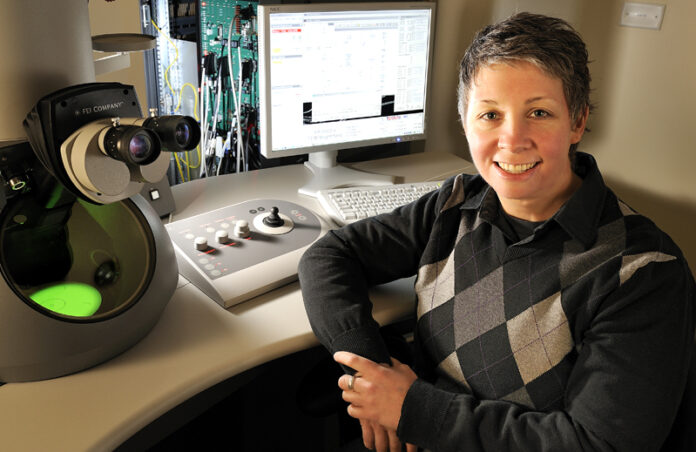
by Paula Byron
A photograph of a polar bear in captivity, no matter how sharp the resolution, can never reveal as much about behavior as footage of that polar bear in its natural habitat. The behavior of cells and molecules can prove even more elusive. Limitations in biomedical imaging technologies have hampered attempts to understand cellular and molecular behavior, with biologists trying to envision dynamic processes through static snapshots.
Deborah Kelly, an assistant professor in the Virginia Tech Carilion Research Institute in Roanoke has developed a novel technology platform to peer closely into the world of cells and molecules within a native, liquid environment.
Kelly and colleagues have developed a way to isolate biological specimens in a flowing, liquid environment while enclosing those specimens in the high-vacuum system of a transmission electron microscope (TEM). The TEM liquid-flow holder, developed by Protochips Inc. of Raleigh, N.C., accommodates biological samples between two semiconductor microchips that are tightly sealed together.
These chips form a microfluidic device smaller than a Tic-Tac. This device, positioned at the tip of an EM specimen holder, permits liquid flow in and out of the holder. When these chips are coated with a special affinity biofilm that Kelly developed, they have the ability to capture cells and molecules rapidly and with high specificity. This system allows researchers to watch — at unprecedented resolution — biological processes as they occur, such as the interaction of a molecule with a receptor on a cell that triggers normal development or cancer.
“With this new technology, we can capture and view the native architecture of cells and their surface protein receptors while learning about their dynamic interactions, such as what happens when cells interact with pathogens or drugs,” said Kelly. “We can now isolate cancer cells, for example, and view the early events of chemotherapy in action.”
Kelly had previously worked with colleagues at Harvard Medical School to develop a way to capture protein machinery in a frozen environment. “But life moves,” said Kelly. “It’s better if biological processes don’t have to be paused or frozen in order to be studied, but can be viewed in dynamic and life-sustaining liquid environments.”
Kelly’s affinity capture device, in combination with high-resolution TEM, helps bridge the gap between cellular and molecular imaging, allowing researchers to achieve spatial resolution as high as two nanometers. “This device allows us to see new features on the surface of live cancer cells, providing new targets for drug therapy,” Kelly said. “With this resolution, scientists may even be able to visualize disease processes as they unfold.”
The research appears in the February issue of an international journal of the Royal Society of Chemistry of London in an article by Katherine Degen, a biomedical engineering student at the University of Virginia; Madeline Dukes, an applications scientist at Protochips; Justin Tanner, a postdoctoral associate at the Virginia Tech Carilion Research Institute; and Kelly, the corresponding author.The institute is located at the new biomedical health sciences campus in Roanoke at 2 Riverside Circle.

